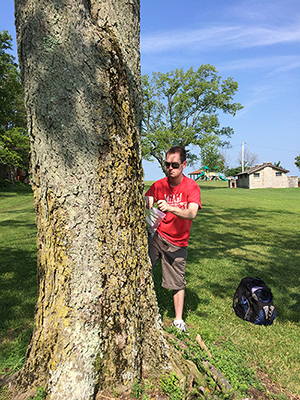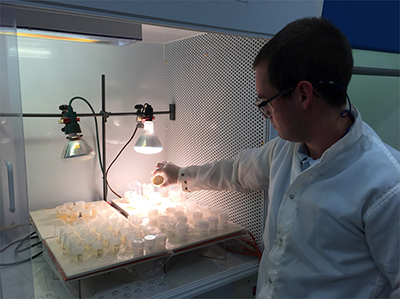Students in the Geology & Environmental Earth Science Department trace environmental contamination near two superfund sites close to campus

Written by Ivy Shtull, CAS communications intern
PhD student Kelly McHugh and undergraduate student Tim Carlson have been conducting environmental contamination research in the vicinity of the Fernald Feed Materials Production Center and the Miamisburg Mound Laboratories Site with Dr. Elisabeth Widom. Both locations are superfund sites, meaning they were heavily contaminated with hazardous wastes.

Tim Carlson collects tree lichens for subsequent analyses.
McHugh, a doctoral candidate in her fourth year who completed her undergraduate degree at Miami, is working on a Committee on Faculty Research (CFR) grant for a Fernald area environmental contamination and nuclear forensics project.
The Fernald site, located in Hamilton County, served as a uranium processing facility for U.S. nuclear weapons production from 1951 to 1989. During that time, the plant was releasing uranium dust into the environment, causing contamination of the entire 1,050-acre site. McHugh's research uses tree rings to trace the past uranium contamination.
"I'm testing whether a tree takes up uranium and locks it in the cell structure for that growth ring or if the uranium stays mobile in the sap of the wood," said McHugh. "If it stays locked in the annual growth ring, then we can use it reliably to look at past contamination and potentially look at issues of nuclear non-proliferation."
"So far, we haven't found a tree species that is storing uranium," she added. "All of it is mobile in the tree, which is very interesting. At this point, we won’t be able to take my results and apply them, but that could change as more results come in."
McHugh is also serving as a primary mentor to Carlson, who is majoring in geology and expects to graduate this winter. Carlson is working on a similar contamination project in the Miamisburg Mound area, where Mound Laboratories, a facility for nuclear weapons research, was working with uranium and plutonium for the Manhattan Project. It also served as a storage and research site for nuclear weapons during the Cold War.
Carlson and McHugh's projects use the same chemistry and lab processes, but they differ in site location and materials. In addition, McHugh's research looks at timing, and Carlson's looks at location.

Tim Carlson analyzes lichens in the laboratory.
Carlson is focused on determining if lichen on tree bark near this site can be used as an indicator of the contamination around the area. If the lichen retains a record of past airborne contamination, it can be used to predict the location of contamination in soil and water.
"My work on lichen is more of a test case about how well lichen records spatial contamination," Carlson said. "I'm hoping that my project will serve as a starting point for future research on lichen."
Both projects give the students a unique opportunity to be hands on and conduct research outside the typical classroom environment. McHugh and Carlson agreed that applying their knowledge in this way will be helpful for future projects.
"Instead of reading it, I'm actually going out and doing the chemistry," said Carlson. "I've learned a lot about lab practices and sampling techniques."
"I went to a nuclear chemistry conference in April in Hawaii, and it was really nice to talk to a lot of government employees who were saying 'this is what we want to see coming from graduate students,'" said McHugh.
The Geology department also provides an exceptional lab experience for students. "Not all graduate programs have lab facilities available to them," McHugh said. "A lot send out samples and get numbers back, and here we get to do the application and run the instruments ourselves. We're fortunate to have that opportunity!"

